Changi Airport: Assessing Social and Economic Impacts
VerifiedAdded on 2023/06/10
|13
|4061
|346
Report
AI Summary
This report provides a comprehensive analysis of the social, economic, and environmental impacts of Changi Airport's operations on the surrounding community in Singapore. It highlights both the benefits, such as improved connectivity, job creation, and economic growth, and the drawbacks, including potential health hazards, environmental pollution, and social disruptions. The report examines how the airport facilitates global connections, boosts tourism, and supports charitable organizations, while also addressing the negative impacts of air travel, such as jet lag and noise pollution. Furthermore, the report delves into the economic advantages, such as increased trade, lower transportation costs, and enhanced productivity, and suggests recommendations to mitigate the negative social and economic impacts, focusing on customer satisfaction, process maintenance, and innovative techniques to reduce fuel prices and expand airline networks. The document is available on Desklib, a platform offering study tools and solved assignments for students.
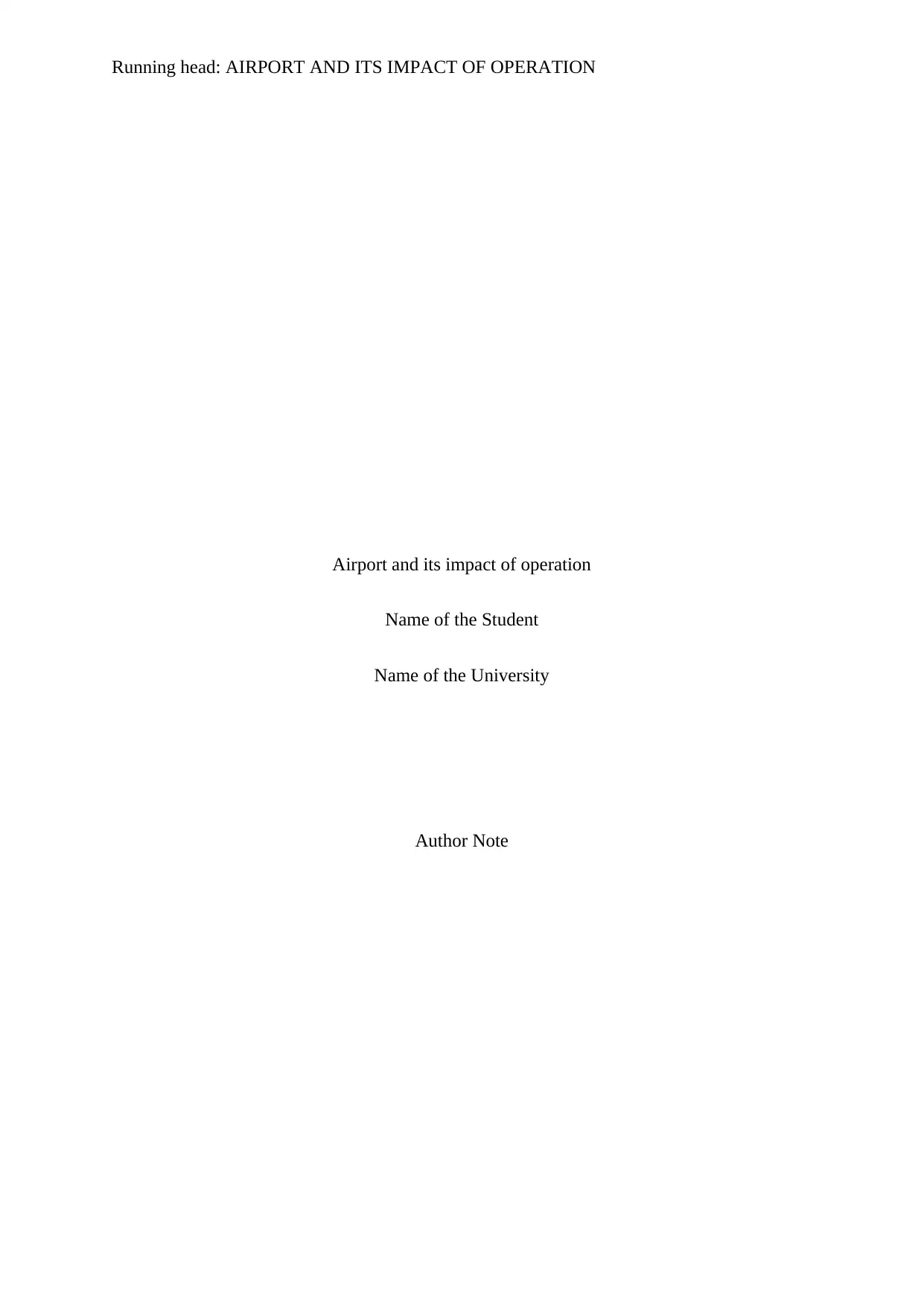
Running head: AIRPORT AND ITS IMPACT OF OPERATION
Airport and its impact of operation
Name of the Student
Name of the University
Author Note
Airport and its impact of operation
Name of the Student
Name of the University
Author Note
Paraphrase This Document
Need a fresh take? Get an instant paraphrase of this document with our AI Paraphraser
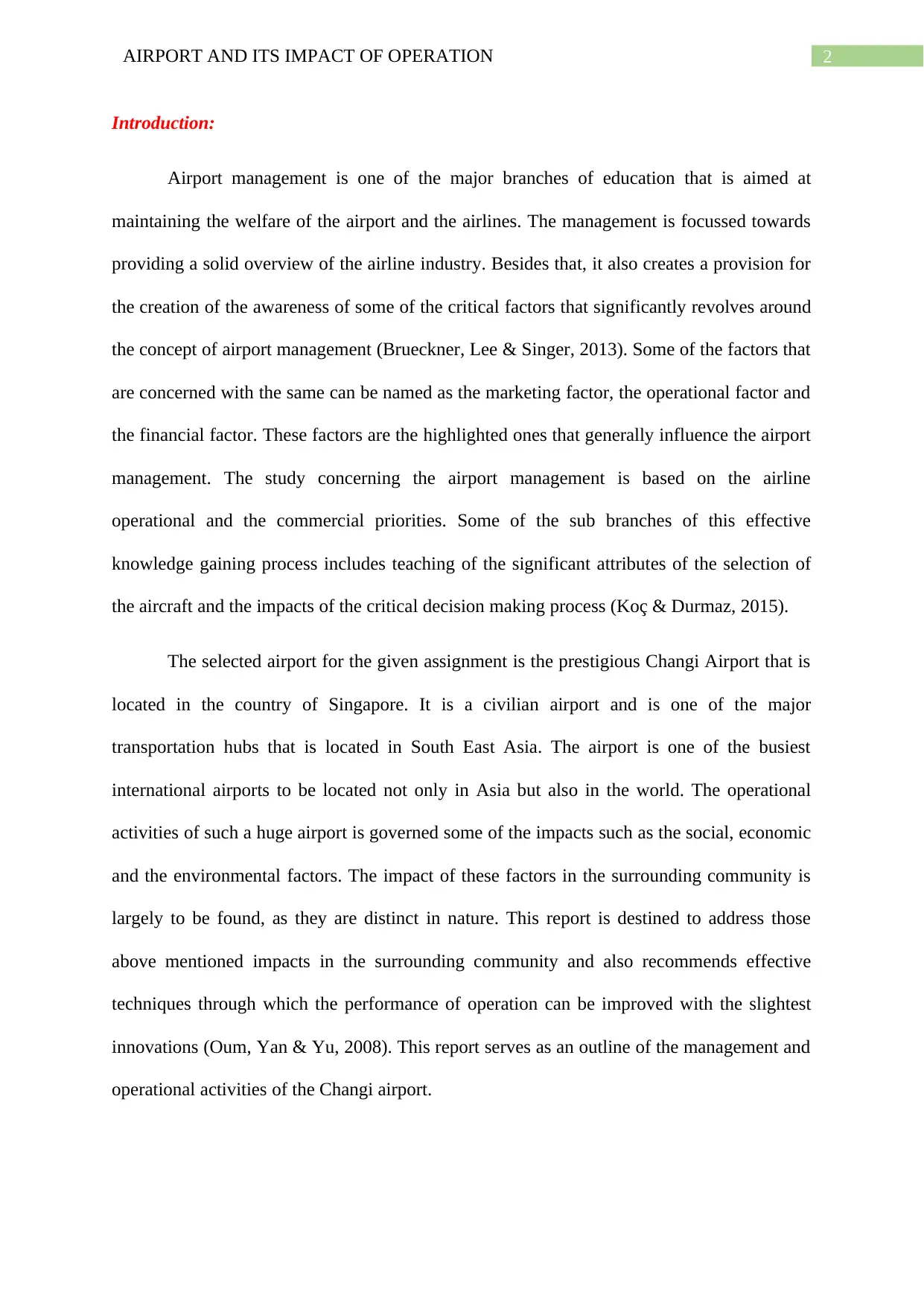
2AIRPORT AND ITS IMPACT OF OPERATION
Introduction:
Airport management is one of the major branches of education that is aimed at
maintaining the welfare of the airport and the airlines. The management is focussed towards
providing a solid overview of the airline industry. Besides that, it also creates a provision for
the creation of the awareness of some of the critical factors that significantly revolves around
the concept of airport management (Brueckner, Lee & Singer, 2013). Some of the factors that
are concerned with the same can be named as the marketing factor, the operational factor and
the financial factor. These factors are the highlighted ones that generally influence the airport
management. The study concerning the airport management is based on the airline
operational and the commercial priorities. Some of the sub branches of this effective
knowledge gaining process includes teaching of the significant attributes of the selection of
the aircraft and the impacts of the critical decision making process (Koç & Durmaz, 2015).
The selected airport for the given assignment is the prestigious Changi Airport that is
located in the country of Singapore. It is a civilian airport and is one of the major
transportation hubs that is located in South East Asia. The airport is one of the busiest
international airports to be located not only in Asia but also in the world. The operational
activities of such a huge airport is governed some of the impacts such as the social, economic
and the environmental factors. The impact of these factors in the surrounding community is
largely to be found, as they are distinct in nature. This report is destined to address those
above mentioned impacts in the surrounding community and also recommends effective
techniques through which the performance of operation can be improved with the slightest
innovations (Oum, Yan & Yu, 2008). This report serves as an outline of the management and
operational activities of the Changi airport.
Introduction:
Airport management is one of the major branches of education that is aimed at
maintaining the welfare of the airport and the airlines. The management is focussed towards
providing a solid overview of the airline industry. Besides that, it also creates a provision for
the creation of the awareness of some of the critical factors that significantly revolves around
the concept of airport management (Brueckner, Lee & Singer, 2013). Some of the factors that
are concerned with the same can be named as the marketing factor, the operational factor and
the financial factor. These factors are the highlighted ones that generally influence the airport
management. The study concerning the airport management is based on the airline
operational and the commercial priorities. Some of the sub branches of this effective
knowledge gaining process includes teaching of the significant attributes of the selection of
the aircraft and the impacts of the critical decision making process (Koç & Durmaz, 2015).
The selected airport for the given assignment is the prestigious Changi Airport that is
located in the country of Singapore. It is a civilian airport and is one of the major
transportation hubs that is located in South East Asia. The airport is one of the busiest
international airports to be located not only in Asia but also in the world. The operational
activities of such a huge airport is governed some of the impacts such as the social, economic
and the environmental factors. The impact of these factors in the surrounding community is
largely to be found, as they are distinct in nature. This report is destined to address those
above mentioned impacts in the surrounding community and also recommends effective
techniques through which the performance of operation can be improved with the slightest
innovations (Oum, Yan & Yu, 2008). This report serves as an outline of the management and
operational activities of the Changi airport.
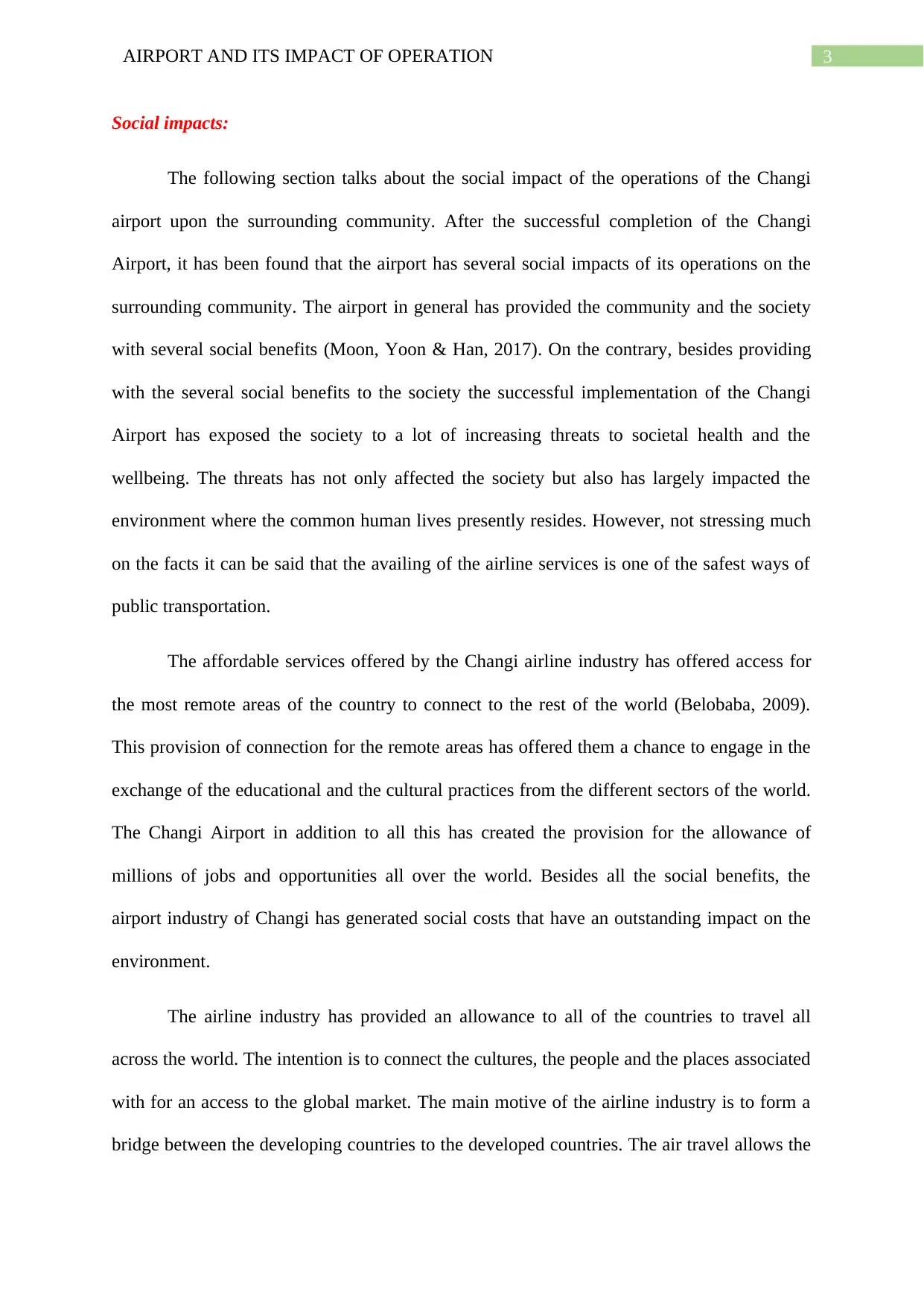
3AIRPORT AND ITS IMPACT OF OPERATION
Social impacts:
The following section talks about the social impact of the operations of the Changi
airport upon the surrounding community. After the successful completion of the Changi
Airport, it has been found that the airport has several social impacts of its operations on the
surrounding community. The airport in general has provided the community and the society
with several social benefits (Moon, Yoon & Han, 2017). On the contrary, besides providing
with the several social benefits to the society the successful implementation of the Changi
Airport has exposed the society to a lot of increasing threats to societal health and the
wellbeing. The threats has not only affected the society but also has largely impacted the
environment where the common human lives presently resides. However, not stressing much
on the facts it can be said that the availing of the airline services is one of the safest ways of
public transportation.
The affordable services offered by the Changi airline industry has offered access for
the most remote areas of the country to connect to the rest of the world (Belobaba, 2009).
This provision of connection for the remote areas has offered them a chance to engage in the
exchange of the educational and the cultural practices from the different sectors of the world.
The Changi Airport in addition to all this has created the provision for the allowance of
millions of jobs and opportunities all over the world. Besides all the social benefits, the
airport industry of Changi has generated social costs that have an outstanding impact on the
environment.
The airline industry has provided an allowance to all of the countries to travel all
across the world. The intention is to connect the cultures, the people and the places associated
with for an access to the global market. The main motive of the airline industry is to form a
bridge between the developing countries to the developed countries. The air travel allows the
Social impacts:
The following section talks about the social impact of the operations of the Changi
airport upon the surrounding community. After the successful completion of the Changi
Airport, it has been found that the airport has several social impacts of its operations on the
surrounding community. The airport in general has provided the community and the society
with several social benefits (Moon, Yoon & Han, 2017). On the contrary, besides providing
with the several social benefits to the society the successful implementation of the Changi
Airport has exposed the society to a lot of increasing threats to societal health and the
wellbeing. The threats has not only affected the society but also has largely impacted the
environment where the common human lives presently resides. However, not stressing much
on the facts it can be said that the availing of the airline services is one of the safest ways of
public transportation.
The affordable services offered by the Changi airline industry has offered access for
the most remote areas of the country to connect to the rest of the world (Belobaba, 2009).
This provision of connection for the remote areas has offered them a chance to engage in the
exchange of the educational and the cultural practices from the different sectors of the world.
The Changi Airport in addition to all this has created the provision for the allowance of
millions of jobs and opportunities all over the world. Besides all the social benefits, the
airport industry of Changi has generated social costs that have an outstanding impact on the
environment.
The airline industry has provided an allowance to all of the countries to travel all
across the world. The intention is to connect the cultures, the people and the places associated
with for an access to the global market. The main motive of the airline industry is to form a
bridge between the developing countries to the developed countries. The air travel allows the
⊘ This is a preview!⊘
Do you want full access?
Subscribe today to unlock all pages.

Trusted by 1+ million students worldwide
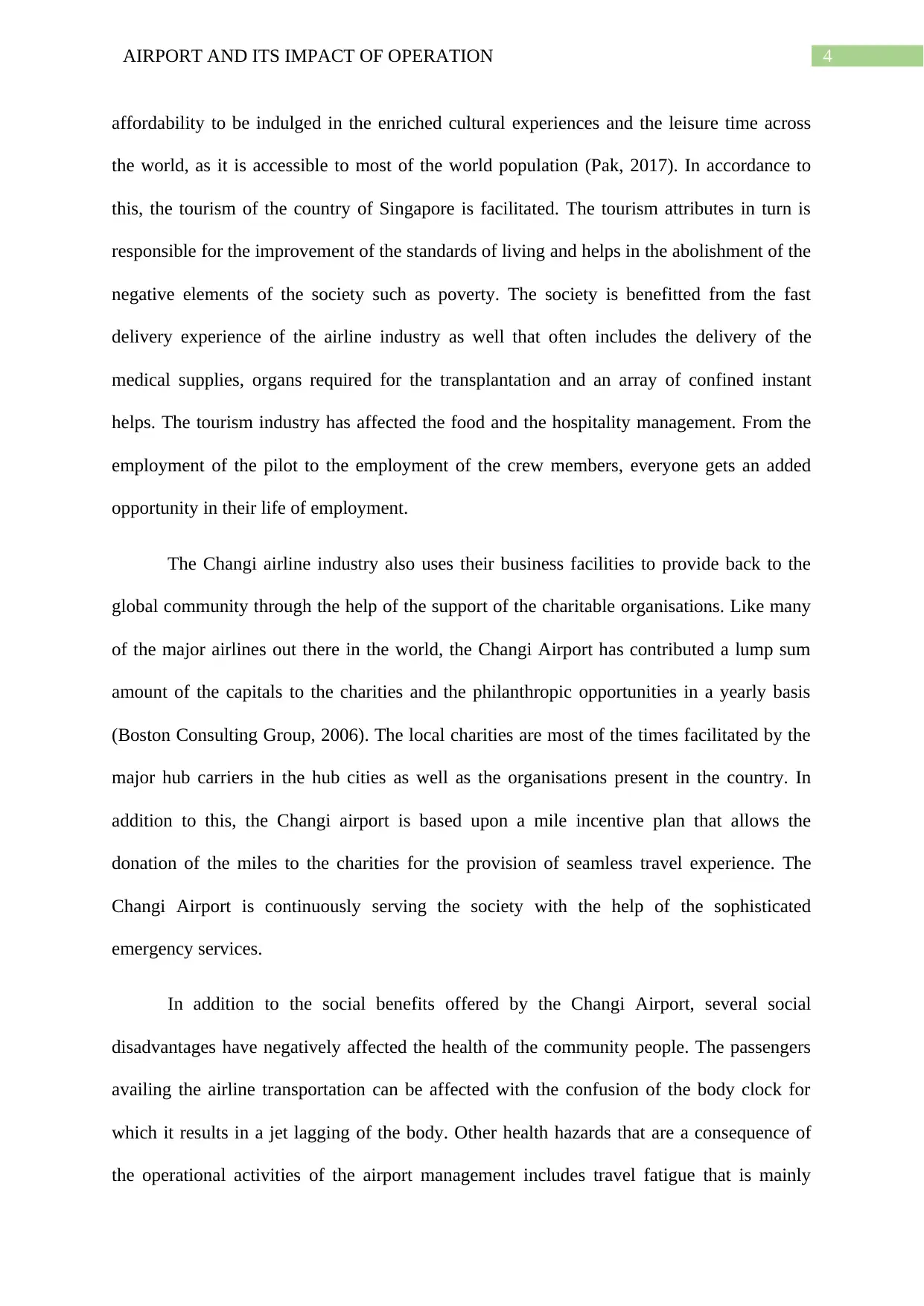
4AIRPORT AND ITS IMPACT OF OPERATION
affordability to be indulged in the enriched cultural experiences and the leisure time across
the world, as it is accessible to most of the world population (Pak, 2017). In accordance to
this, the tourism of the country of Singapore is facilitated. The tourism attributes in turn is
responsible for the improvement of the standards of living and helps in the abolishment of the
negative elements of the society such as poverty. The society is benefitted from the fast
delivery experience of the airline industry as well that often includes the delivery of the
medical supplies, organs required for the transplantation and an array of confined instant
helps. The tourism industry has affected the food and the hospitality management. From the
employment of the pilot to the employment of the crew members, everyone gets an added
opportunity in their life of employment.
The Changi airline industry also uses their business facilities to provide back to the
global community through the help of the support of the charitable organisations. Like many
of the major airlines out there in the world, the Changi Airport has contributed a lump sum
amount of the capitals to the charities and the philanthropic opportunities in a yearly basis
(Boston Consulting Group, 2006). The local charities are most of the times facilitated by the
major hub carriers in the hub cities as well as the organisations present in the country. In
addition to this, the Changi airport is based upon a mile incentive plan that allows the
donation of the miles to the charities for the provision of seamless travel experience. The
Changi Airport is continuously serving the society with the help of the sophisticated
emergency services.
In addition to the social benefits offered by the Changi Airport, several social
disadvantages have negatively affected the health of the community people. The passengers
availing the airline transportation can be affected with the confusion of the body clock for
which it results in a jet lagging of the body. Other health hazards that are a consequence of
the operational activities of the airport management includes travel fatigue that is mainly
affordability to be indulged in the enriched cultural experiences and the leisure time across
the world, as it is accessible to most of the world population (Pak, 2017). In accordance to
this, the tourism of the country of Singapore is facilitated. The tourism attributes in turn is
responsible for the improvement of the standards of living and helps in the abolishment of the
negative elements of the society such as poverty. The society is benefitted from the fast
delivery experience of the airline industry as well that often includes the delivery of the
medical supplies, organs required for the transplantation and an array of confined instant
helps. The tourism industry has affected the food and the hospitality management. From the
employment of the pilot to the employment of the crew members, everyone gets an added
opportunity in their life of employment.
The Changi airline industry also uses their business facilities to provide back to the
global community through the help of the support of the charitable organisations. Like many
of the major airlines out there in the world, the Changi Airport has contributed a lump sum
amount of the capitals to the charities and the philanthropic opportunities in a yearly basis
(Boston Consulting Group, 2006). The local charities are most of the times facilitated by the
major hub carriers in the hub cities as well as the organisations present in the country. In
addition to this, the Changi airport is based upon a mile incentive plan that allows the
donation of the miles to the charities for the provision of seamless travel experience. The
Changi Airport is continuously serving the society with the help of the sophisticated
emergency services.
In addition to the social benefits offered by the Changi Airport, several social
disadvantages have negatively affected the health of the community people. The passengers
availing the airline transportation can be affected with the confusion of the body clock for
which it results in a jet lagging of the body. Other health hazards that are a consequence of
the operational activities of the airport management includes travel fatigue that is mainly
Paraphrase This Document
Need a fresh take? Get an instant paraphrase of this document with our AI Paraphraser
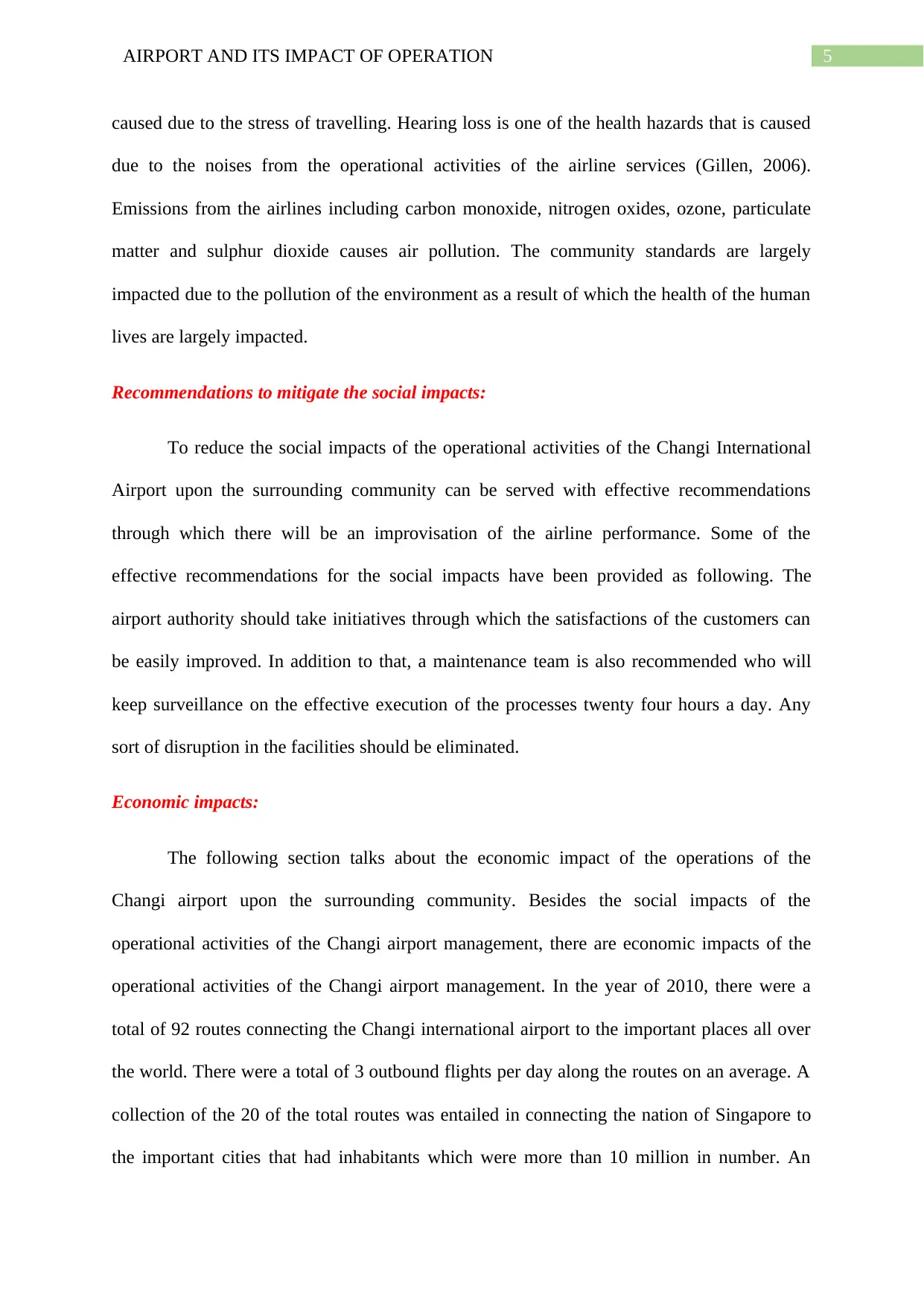
5AIRPORT AND ITS IMPACT OF OPERATION
caused due to the stress of travelling. Hearing loss is one of the health hazards that is caused
due to the noises from the operational activities of the airline services (Gillen, 2006).
Emissions from the airlines including carbon monoxide, nitrogen oxides, ozone, particulate
matter and sulphur dioxide causes air pollution. The community standards are largely
impacted due to the pollution of the environment as a result of which the health of the human
lives are largely impacted.
Recommendations to mitigate the social impacts:
To reduce the social impacts of the operational activities of the Changi International
Airport upon the surrounding community can be served with effective recommendations
through which there will be an improvisation of the airline performance. Some of the
effective recommendations for the social impacts have been provided as following. The
airport authority should take initiatives through which the satisfactions of the customers can
be easily improved. In addition to that, a maintenance team is also recommended who will
keep surveillance on the effective execution of the processes twenty four hours a day. Any
sort of disruption in the facilities should be eliminated.
Economic impacts:
The following section talks about the economic impact of the operations of the
Changi airport upon the surrounding community. Besides the social impacts of the
operational activities of the Changi airport management, there are economic impacts of the
operational activities of the Changi airport management. In the year of 2010, there were a
total of 92 routes connecting the Changi international airport to the important places all over
the world. There were a total of 3 outbound flights per day along the routes on an average. A
collection of the 20 of the total routes was entailed in connecting the nation of Singapore to
the important cities that had inhabitants which were more than 10 million in number. An
caused due to the stress of travelling. Hearing loss is one of the health hazards that is caused
due to the noises from the operational activities of the airline services (Gillen, 2006).
Emissions from the airlines including carbon monoxide, nitrogen oxides, ozone, particulate
matter and sulphur dioxide causes air pollution. The community standards are largely
impacted due to the pollution of the environment as a result of which the health of the human
lives are largely impacted.
Recommendations to mitigate the social impacts:
To reduce the social impacts of the operational activities of the Changi International
Airport upon the surrounding community can be served with effective recommendations
through which there will be an improvisation of the airline performance. Some of the
effective recommendations for the social impacts have been provided as following. The
airport authority should take initiatives through which the satisfactions of the customers can
be easily improved. In addition to that, a maintenance team is also recommended who will
keep surveillance on the effective execution of the processes twenty four hours a day. Any
sort of disruption in the facilities should be eliminated.
Economic impacts:
The following section talks about the economic impact of the operations of the
Changi airport upon the surrounding community. Besides the social impacts of the
operational activities of the Changi airport management, there are economic impacts of the
operational activities of the Changi airport management. In the year of 2010, there were a
total of 92 routes connecting the Changi international airport to the important places all over
the world. There were a total of 3 outbound flights per day along the routes on an average. A
collection of the 20 of the total routes was entailed in connecting the nation of Singapore to
the important cities that had inhabitants which were more than 10 million in number. An
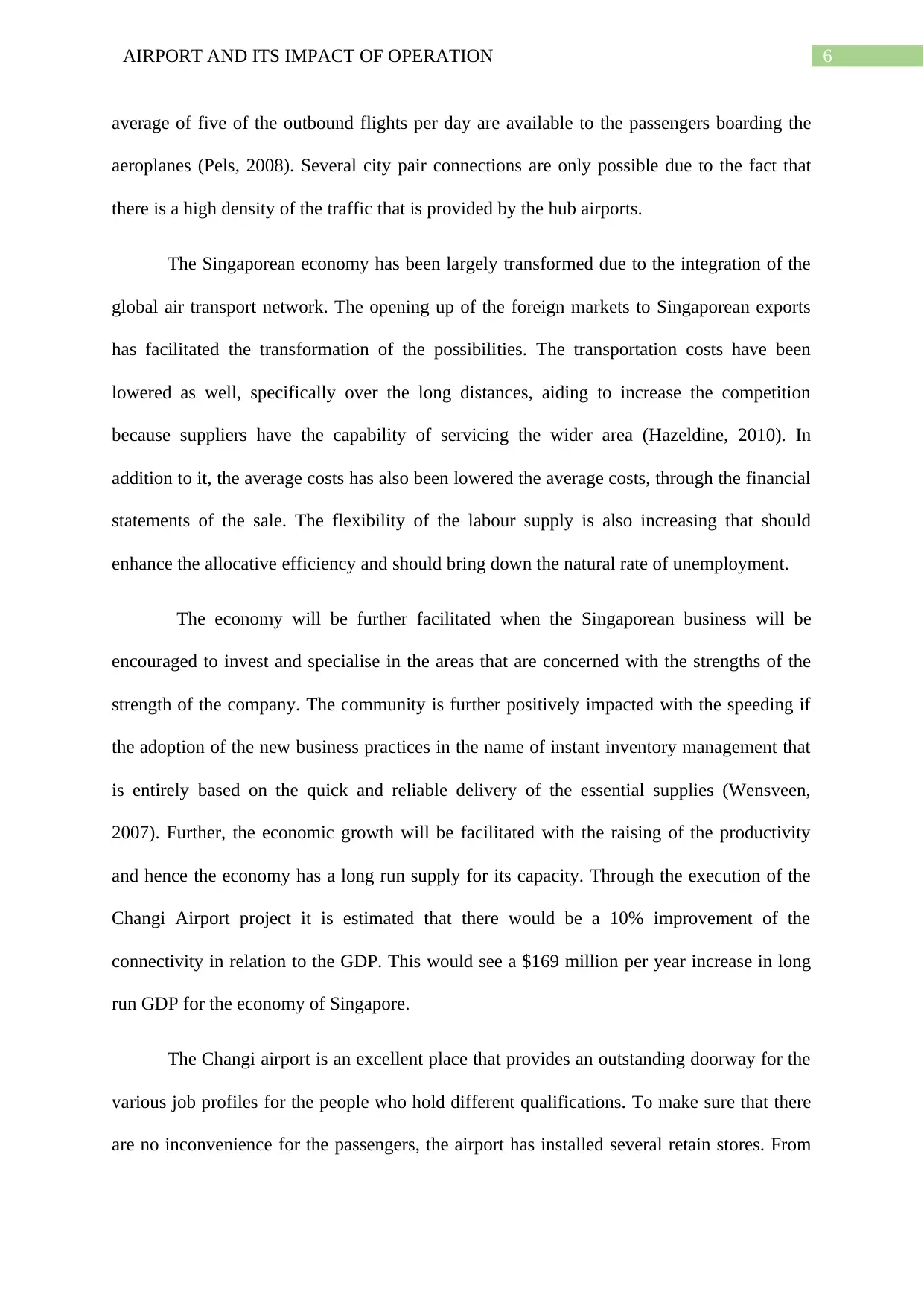
6AIRPORT AND ITS IMPACT OF OPERATION
average of five of the outbound flights per day are available to the passengers boarding the
aeroplanes (Pels, 2008). Several city pair connections are only possible due to the fact that
there is a high density of the traffic that is provided by the hub airports.
The Singaporean economy has been largely transformed due to the integration of the
global air transport network. The opening up of the foreign markets to Singaporean exports
has facilitated the transformation of the possibilities. The transportation costs have been
lowered as well, specifically over the long distances, aiding to increase the competition
because suppliers have the capability of servicing the wider area (Hazeldine, 2010). In
addition to it, the average costs has also been lowered the average costs, through the financial
statements of the sale. The flexibility of the labour supply is also increasing that should
enhance the allocative efficiency and should bring down the natural rate of unemployment.
The economy will be further facilitated when the Singaporean business will be
encouraged to invest and specialise in the areas that are concerned with the strengths of the
strength of the company. The community is further positively impacted with the speeding if
the adoption of the new business practices in the name of instant inventory management that
is entirely based on the quick and reliable delivery of the essential supplies (Wensveen,
2007). Further, the economic growth will be facilitated with the raising of the productivity
and hence the economy has a long run supply for its capacity. Through the execution of the
Changi Airport project it is estimated that there would be a 10% improvement of the
connectivity in relation to the GDP. This would see a $169 million per year increase in long
run GDP for the economy of Singapore.
The Changi airport is an excellent place that provides an outstanding doorway for the
various job profiles for the people who hold different qualifications. To make sure that there
are no inconvenience for the passengers, the airport has installed several retain stores. From
average of five of the outbound flights per day are available to the passengers boarding the
aeroplanes (Pels, 2008). Several city pair connections are only possible due to the fact that
there is a high density of the traffic that is provided by the hub airports.
The Singaporean economy has been largely transformed due to the integration of the
global air transport network. The opening up of the foreign markets to Singaporean exports
has facilitated the transformation of the possibilities. The transportation costs have been
lowered as well, specifically over the long distances, aiding to increase the competition
because suppliers have the capability of servicing the wider area (Hazeldine, 2010). In
addition to it, the average costs has also been lowered the average costs, through the financial
statements of the sale. The flexibility of the labour supply is also increasing that should
enhance the allocative efficiency and should bring down the natural rate of unemployment.
The economy will be further facilitated when the Singaporean business will be
encouraged to invest and specialise in the areas that are concerned with the strengths of the
strength of the company. The community is further positively impacted with the speeding if
the adoption of the new business practices in the name of instant inventory management that
is entirely based on the quick and reliable delivery of the essential supplies (Wensveen,
2007). Further, the economic growth will be facilitated with the raising of the productivity
and hence the economy has a long run supply for its capacity. Through the execution of the
Changi Airport project it is estimated that there would be a 10% improvement of the
connectivity in relation to the GDP. This would see a $169 million per year increase in long
run GDP for the economy of Singapore.
The Changi airport is an excellent place that provides an outstanding doorway for the
various job profiles for the people who hold different qualifications. To make sure that there
are no inconvenience for the passengers, the airport has installed several retain stores. From
⊘ This is a preview!⊘
Do you want full access?
Subscribe today to unlock all pages.

Trusted by 1+ million students worldwide
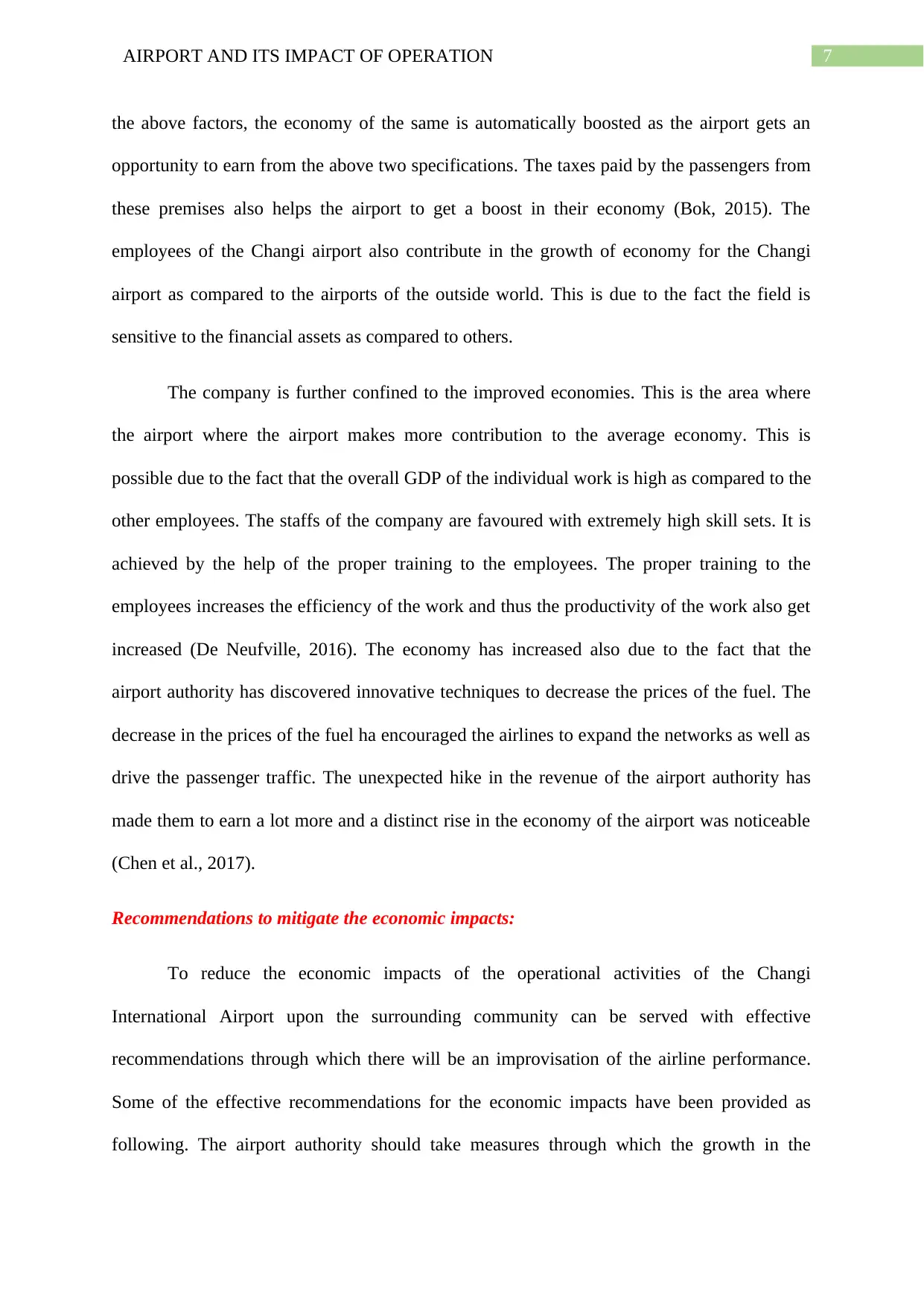
7AIRPORT AND ITS IMPACT OF OPERATION
the above factors, the economy of the same is automatically boosted as the airport gets an
opportunity to earn from the above two specifications. The taxes paid by the passengers from
these premises also helps the airport to get a boost in their economy (Bok, 2015). The
employees of the Changi airport also contribute in the growth of economy for the Changi
airport as compared to the airports of the outside world. This is due to the fact the field is
sensitive to the financial assets as compared to others.
The company is further confined to the improved economies. This is the area where
the airport where the airport makes more contribution to the average economy. This is
possible due to the fact that the overall GDP of the individual work is high as compared to the
other employees. The staffs of the company are favoured with extremely high skill sets. It is
achieved by the help of the proper training to the employees. The proper training to the
employees increases the efficiency of the work and thus the productivity of the work also get
increased (De Neufville, 2016). The economy has increased also due to the fact that the
airport authority has discovered innovative techniques to decrease the prices of the fuel. The
decrease in the prices of the fuel ha encouraged the airlines to expand the networks as well as
drive the passenger traffic. The unexpected hike in the revenue of the airport authority has
made them to earn a lot more and a distinct rise in the economy of the airport was noticeable
(Chen et al., 2017).
Recommendations to mitigate the economic impacts:
To reduce the economic impacts of the operational activities of the Changi
International Airport upon the surrounding community can be served with effective
recommendations through which there will be an improvisation of the airline performance.
Some of the effective recommendations for the economic impacts have been provided as
following. The airport authority should take measures through which the growth in the
the above factors, the economy of the same is automatically boosted as the airport gets an
opportunity to earn from the above two specifications. The taxes paid by the passengers from
these premises also helps the airport to get a boost in their economy (Bok, 2015). The
employees of the Changi airport also contribute in the growth of economy for the Changi
airport as compared to the airports of the outside world. This is due to the fact the field is
sensitive to the financial assets as compared to others.
The company is further confined to the improved economies. This is the area where
the airport where the airport makes more contribution to the average economy. This is
possible due to the fact that the overall GDP of the individual work is high as compared to the
other employees. The staffs of the company are favoured with extremely high skill sets. It is
achieved by the help of the proper training to the employees. The proper training to the
employees increases the efficiency of the work and thus the productivity of the work also get
increased (De Neufville, 2016). The economy has increased also due to the fact that the
airport authority has discovered innovative techniques to decrease the prices of the fuel. The
decrease in the prices of the fuel ha encouraged the airlines to expand the networks as well as
drive the passenger traffic. The unexpected hike in the revenue of the airport authority has
made them to earn a lot more and a distinct rise in the economy of the airport was noticeable
(Chen et al., 2017).
Recommendations to mitigate the economic impacts:
To reduce the economic impacts of the operational activities of the Changi
International Airport upon the surrounding community can be served with effective
recommendations through which there will be an improvisation of the airline performance.
Some of the effective recommendations for the economic impacts have been provided as
following. The airport authority should take measures through which the growth in the
Paraphrase This Document
Need a fresh take? Get an instant paraphrase of this document with our AI Paraphraser
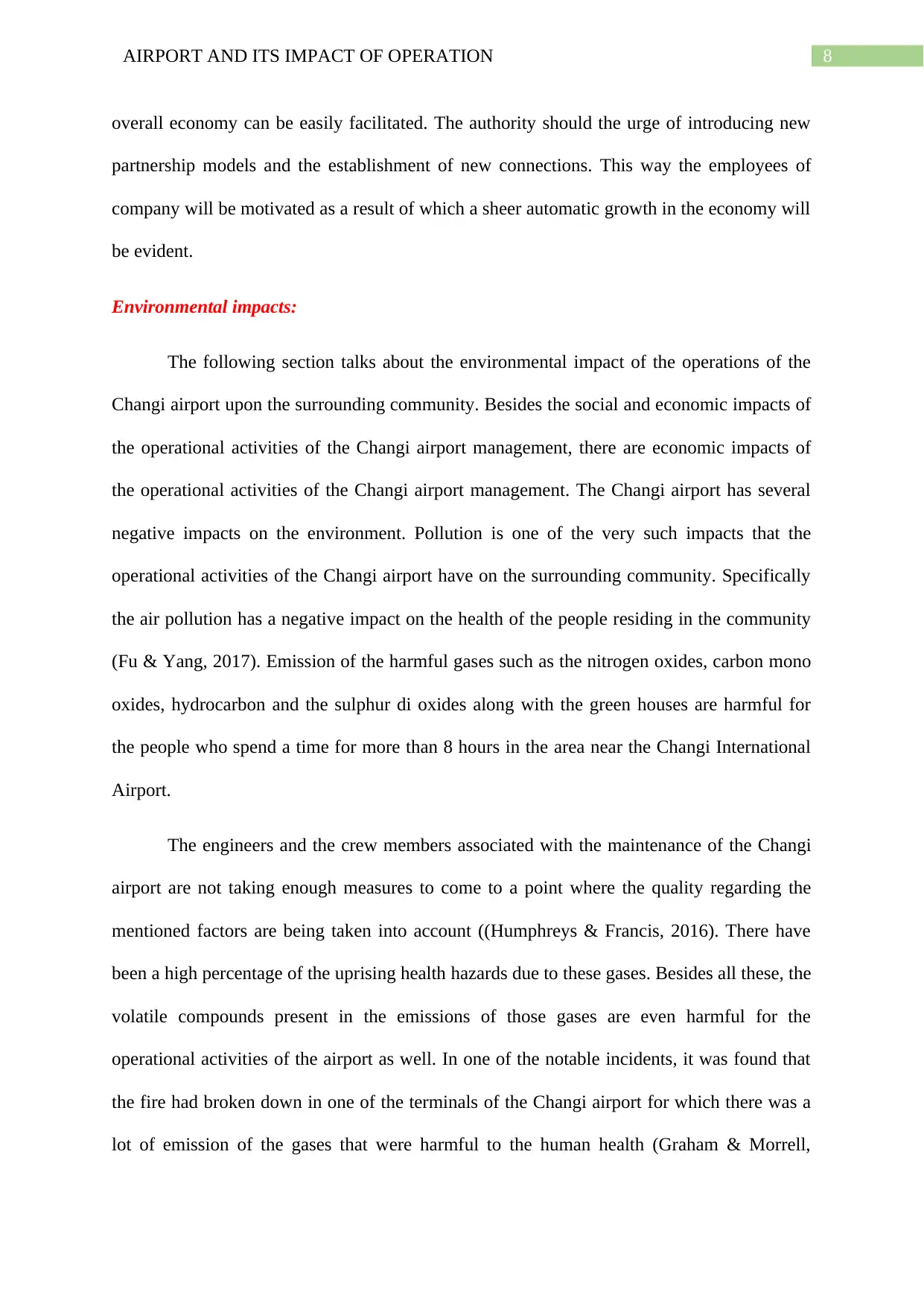
8AIRPORT AND ITS IMPACT OF OPERATION
overall economy can be easily facilitated. The authority should the urge of introducing new
partnership models and the establishment of new connections. This way the employees of
company will be motivated as a result of which a sheer automatic growth in the economy will
be evident.
Environmental impacts:
The following section talks about the environmental impact of the operations of the
Changi airport upon the surrounding community. Besides the social and economic impacts of
the operational activities of the Changi airport management, there are economic impacts of
the operational activities of the Changi airport management. The Changi airport has several
negative impacts on the environment. Pollution is one of the very such impacts that the
operational activities of the Changi airport have on the surrounding community. Specifically
the air pollution has a negative impact on the health of the people residing in the community
(Fu & Yang, 2017). Emission of the harmful gases such as the nitrogen oxides, carbon mono
oxides, hydrocarbon and the sulphur di oxides along with the green houses are harmful for
the people who spend a time for more than 8 hours in the area near the Changi International
Airport.
The engineers and the crew members associated with the maintenance of the Changi
airport are not taking enough measures to come to a point where the quality regarding the
mentioned factors are being taken into account ((Humphreys & Francis, 2016). There have
been a high percentage of the uprising health hazards due to these gases. Besides all these, the
volatile compounds present in the emissions of those gases are even harmful for the
operational activities of the airport as well. In one of the notable incidents, it was found that
the fire had broken down in one of the terminals of the Changi airport for which there was a
lot of emission of the gases that were harmful to the human health (Graham & Morrell,
overall economy can be easily facilitated. The authority should the urge of introducing new
partnership models and the establishment of new connections. This way the employees of
company will be motivated as a result of which a sheer automatic growth in the economy will
be evident.
Environmental impacts:
The following section talks about the environmental impact of the operations of the
Changi airport upon the surrounding community. Besides the social and economic impacts of
the operational activities of the Changi airport management, there are economic impacts of
the operational activities of the Changi airport management. The Changi airport has several
negative impacts on the environment. Pollution is one of the very such impacts that the
operational activities of the Changi airport have on the surrounding community. Specifically
the air pollution has a negative impact on the health of the people residing in the community
(Fu & Yang, 2017). Emission of the harmful gases such as the nitrogen oxides, carbon mono
oxides, hydrocarbon and the sulphur di oxides along with the green houses are harmful for
the people who spend a time for more than 8 hours in the area near the Changi International
Airport.
The engineers and the crew members associated with the maintenance of the Changi
airport are not taking enough measures to come to a point where the quality regarding the
mentioned factors are being taken into account ((Humphreys & Francis, 2016). There have
been a high percentage of the uprising health hazards due to these gases. Besides all these, the
volatile compounds present in the emissions of those gases are even harmful for the
operational activities of the airport as well. In one of the notable incidents, it was found that
the fire had broken down in one of the terminals of the Changi airport for which there was a
lot of emission of the gases that were harmful to the human health (Graham & Morrell,
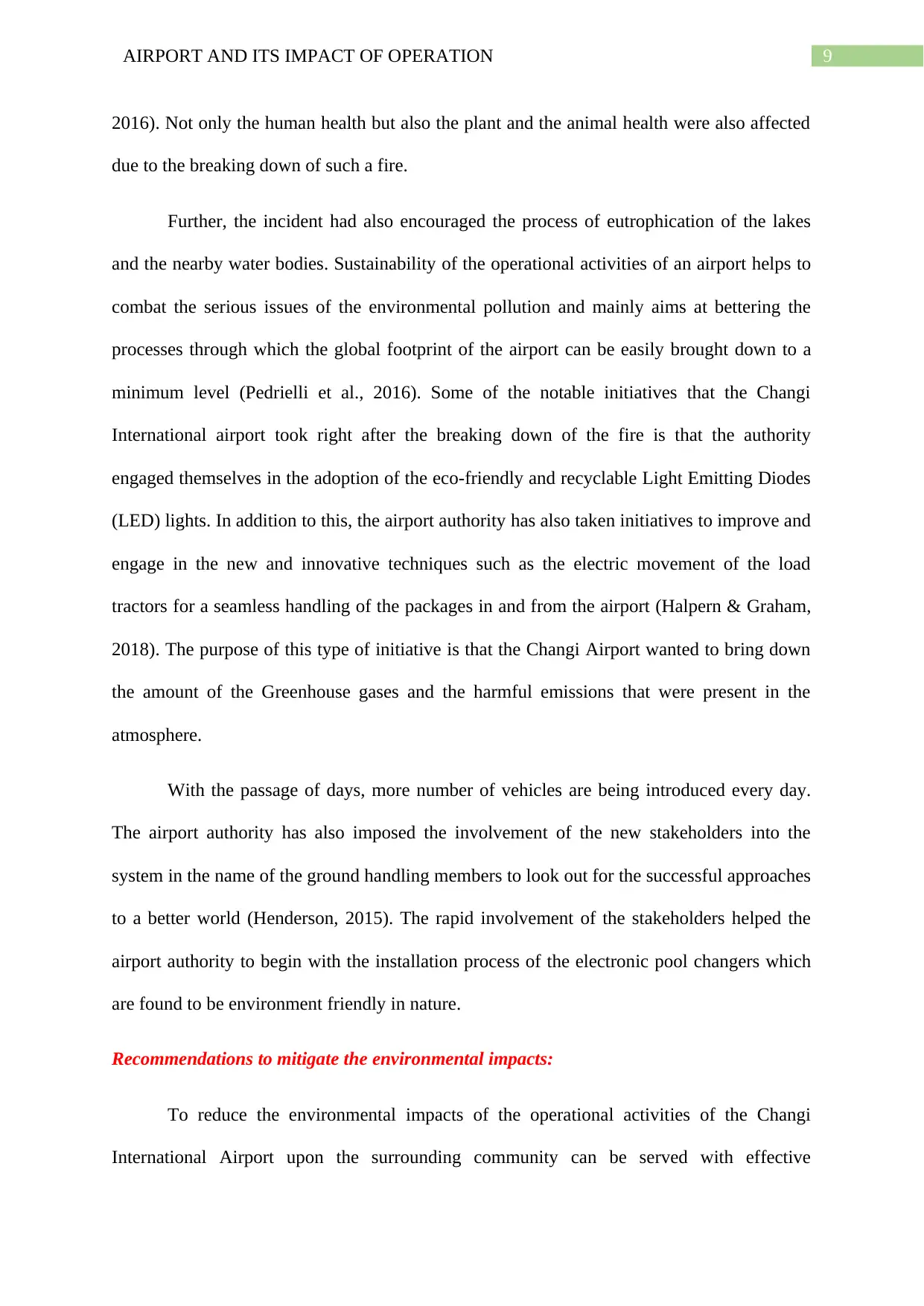
9AIRPORT AND ITS IMPACT OF OPERATION
2016). Not only the human health but also the plant and the animal health were also affected
due to the breaking down of such a fire.
Further, the incident had also encouraged the process of eutrophication of the lakes
and the nearby water bodies. Sustainability of the operational activities of an airport helps to
combat the serious issues of the environmental pollution and mainly aims at bettering the
processes through which the global footprint of the airport can be easily brought down to a
minimum level (Pedrielli et al., 2016). Some of the notable initiatives that the Changi
International airport took right after the breaking down of the fire is that the authority
engaged themselves in the adoption of the eco-friendly and recyclable Light Emitting Diodes
(LED) lights. In addition to this, the airport authority has also taken initiatives to improve and
engage in the new and innovative techniques such as the electric movement of the load
tractors for a seamless handling of the packages in and from the airport (Halpern & Graham,
2018). The purpose of this type of initiative is that the Changi Airport wanted to bring down
the amount of the Greenhouse gases and the harmful emissions that were present in the
atmosphere.
With the passage of days, more number of vehicles are being introduced every day.
The airport authority has also imposed the involvement of the new stakeholders into the
system in the name of the ground handling members to look out for the successful approaches
to a better world (Henderson, 2015). The rapid involvement of the stakeholders helped the
airport authority to begin with the installation process of the electronic pool changers which
are found to be environment friendly in nature.
Recommendations to mitigate the environmental impacts:
To reduce the environmental impacts of the operational activities of the Changi
International Airport upon the surrounding community can be served with effective
2016). Not only the human health but also the plant and the animal health were also affected
due to the breaking down of such a fire.
Further, the incident had also encouraged the process of eutrophication of the lakes
and the nearby water bodies. Sustainability of the operational activities of an airport helps to
combat the serious issues of the environmental pollution and mainly aims at bettering the
processes through which the global footprint of the airport can be easily brought down to a
minimum level (Pedrielli et al., 2016). Some of the notable initiatives that the Changi
International airport took right after the breaking down of the fire is that the authority
engaged themselves in the adoption of the eco-friendly and recyclable Light Emitting Diodes
(LED) lights. In addition to this, the airport authority has also taken initiatives to improve and
engage in the new and innovative techniques such as the electric movement of the load
tractors for a seamless handling of the packages in and from the airport (Halpern & Graham,
2018). The purpose of this type of initiative is that the Changi Airport wanted to bring down
the amount of the Greenhouse gases and the harmful emissions that were present in the
atmosphere.
With the passage of days, more number of vehicles are being introduced every day.
The airport authority has also imposed the involvement of the new stakeholders into the
system in the name of the ground handling members to look out for the successful approaches
to a better world (Henderson, 2015). The rapid involvement of the stakeholders helped the
airport authority to begin with the installation process of the electronic pool changers which
are found to be environment friendly in nature.
Recommendations to mitigate the environmental impacts:
To reduce the environmental impacts of the operational activities of the Changi
International Airport upon the surrounding community can be served with effective
⊘ This is a preview!⊘
Do you want full access?
Subscribe today to unlock all pages.

Trusted by 1+ million students worldwide
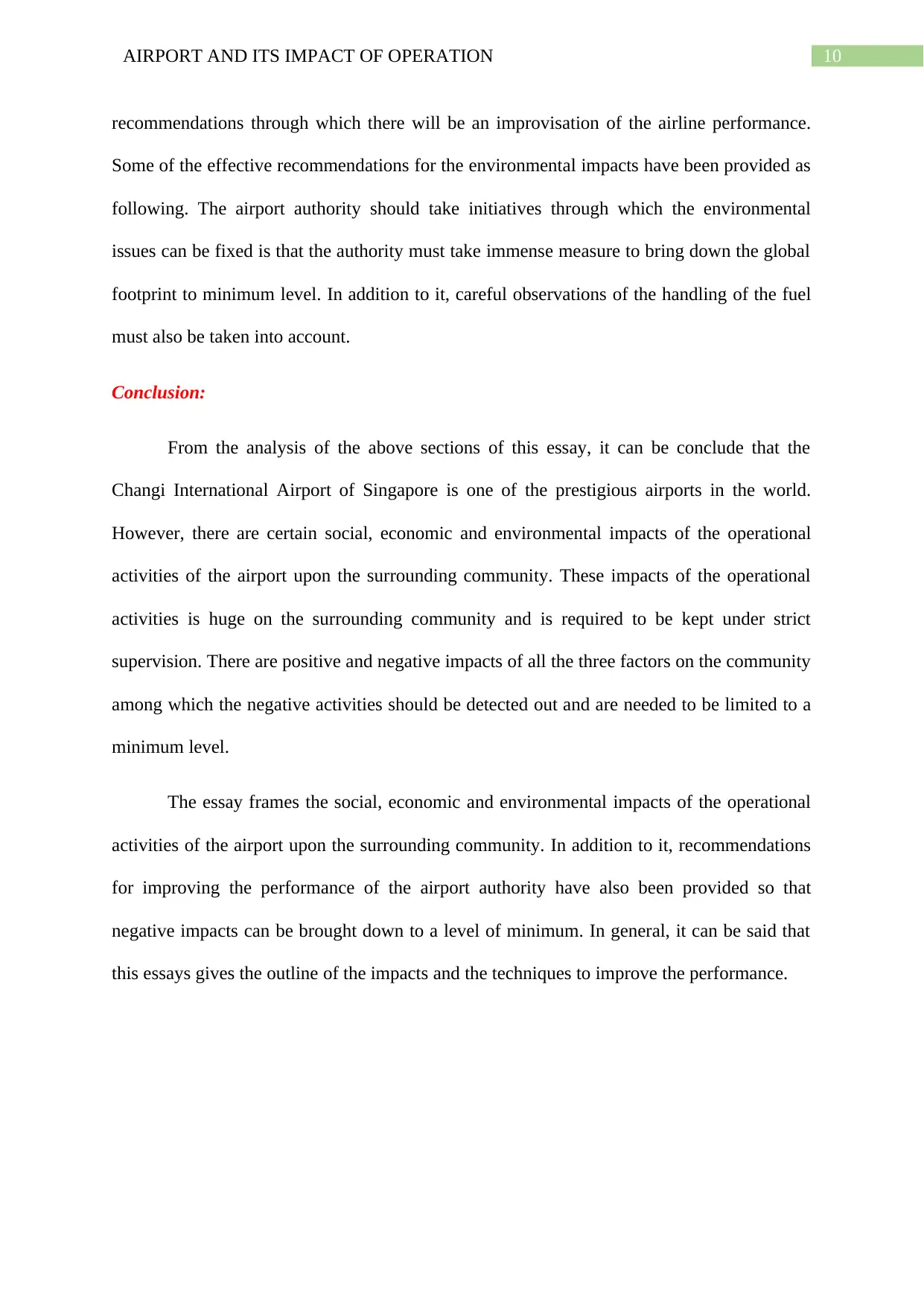
10AIRPORT AND ITS IMPACT OF OPERATION
recommendations through which there will be an improvisation of the airline performance.
Some of the effective recommendations for the environmental impacts have been provided as
following. The airport authority should take initiatives through which the environmental
issues can be fixed is that the authority must take immense measure to bring down the global
footprint to minimum level. In addition to it, careful observations of the handling of the fuel
must also be taken into account.
Conclusion:
From the analysis of the above sections of this essay, it can be conclude that the
Changi International Airport of Singapore is one of the prestigious airports in the world.
However, there are certain social, economic and environmental impacts of the operational
activities of the airport upon the surrounding community. These impacts of the operational
activities is huge on the surrounding community and is required to be kept under strict
supervision. There are positive and negative impacts of all the three factors on the community
among which the negative activities should be detected out and are needed to be limited to a
minimum level.
The essay frames the social, economic and environmental impacts of the operational
activities of the airport upon the surrounding community. In addition to it, recommendations
for improving the performance of the airport authority have also been provided so that
negative impacts can be brought down to a level of minimum. In general, it can be said that
this essays gives the outline of the impacts and the techniques to improve the performance.
recommendations through which there will be an improvisation of the airline performance.
Some of the effective recommendations for the environmental impacts have been provided as
following. The airport authority should take initiatives through which the environmental
issues can be fixed is that the authority must take immense measure to bring down the global
footprint to minimum level. In addition to it, careful observations of the handling of the fuel
must also be taken into account.
Conclusion:
From the analysis of the above sections of this essay, it can be conclude that the
Changi International Airport of Singapore is one of the prestigious airports in the world.
However, there are certain social, economic and environmental impacts of the operational
activities of the airport upon the surrounding community. These impacts of the operational
activities is huge on the surrounding community and is required to be kept under strict
supervision. There are positive and negative impacts of all the three factors on the community
among which the negative activities should be detected out and are needed to be limited to a
minimum level.
The essay frames the social, economic and environmental impacts of the operational
activities of the airport upon the surrounding community. In addition to it, recommendations
for improving the performance of the airport authority have also been provided so that
negative impacts can be brought down to a level of minimum. In general, it can be said that
this essays gives the outline of the impacts and the techniques to improve the performance.
Paraphrase This Document
Need a fresh take? Get an instant paraphrase of this document with our AI Paraphraser
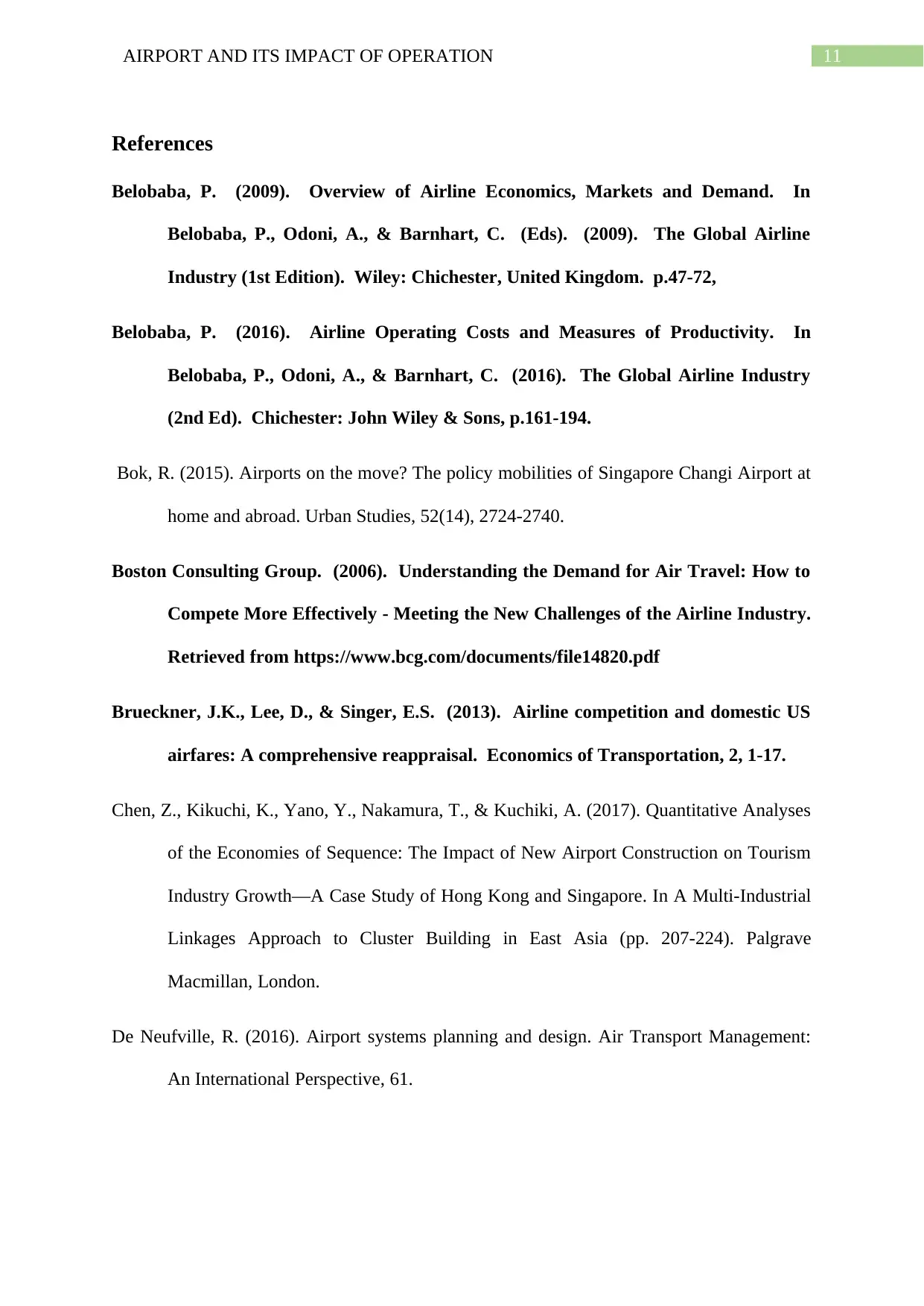
11AIRPORT AND ITS IMPACT OF OPERATION
References
Belobaba, P. (2009). Overview of Airline Economics, Markets and Demand. In
Belobaba, P., Odoni, A., & Barnhart, C. (Eds). (2009). The Global Airline
Industry (1st Edition). Wiley: Chichester, United Kingdom. p.47-72,
Belobaba, P. (2016). Airline Operating Costs and Measures of Productivity. In
Belobaba, P., Odoni, A., & Barnhart, C. (2016). The Global Airline Industry
(2nd Ed). Chichester: John Wiley & Sons, p.161-194.
Bok, R. (2015). Airports on the move? The policy mobilities of Singapore Changi Airport at
home and abroad. Urban Studies, 52(14), 2724-2740.
Boston Consulting Group. (2006). Understanding the Demand for Air Travel: How to
Compete More Effectively - Meeting the New Challenges of the Airline Industry.
Retrieved from https://www.bcg.com/documents/file14820.pdf
Brueckner, J.K., Lee, D., & Singer, E.S. (2013). Airline competition and domestic US
airfares: A comprehensive reappraisal. Economics of Transportation, 2, 1-17.
Chen, Z., Kikuchi, K., Yano, Y., Nakamura, T., & Kuchiki, A. (2017). Quantitative Analyses
of the Economies of Sequence: The Impact of New Airport Construction on Tourism
Industry Growth—A Case Study of Hong Kong and Singapore. In A Multi-Industrial
Linkages Approach to Cluster Building in East Asia (pp. 207-224). Palgrave
Macmillan, London.
De Neufville, R. (2016). Airport systems planning and design. Air Transport Management:
An International Perspective, 61.
References
Belobaba, P. (2009). Overview of Airline Economics, Markets and Demand. In
Belobaba, P., Odoni, A., & Barnhart, C. (Eds). (2009). The Global Airline
Industry (1st Edition). Wiley: Chichester, United Kingdom. p.47-72,
Belobaba, P. (2016). Airline Operating Costs and Measures of Productivity. In
Belobaba, P., Odoni, A., & Barnhart, C. (2016). The Global Airline Industry
(2nd Ed). Chichester: John Wiley & Sons, p.161-194.
Bok, R. (2015). Airports on the move? The policy mobilities of Singapore Changi Airport at
home and abroad. Urban Studies, 52(14), 2724-2740.
Boston Consulting Group. (2006). Understanding the Demand for Air Travel: How to
Compete More Effectively - Meeting the New Challenges of the Airline Industry.
Retrieved from https://www.bcg.com/documents/file14820.pdf
Brueckner, J.K., Lee, D., & Singer, E.S. (2013). Airline competition and domestic US
airfares: A comprehensive reappraisal. Economics of Transportation, 2, 1-17.
Chen, Z., Kikuchi, K., Yano, Y., Nakamura, T., & Kuchiki, A. (2017). Quantitative Analyses
of the Economies of Sequence: The Impact of New Airport Construction on Tourism
Industry Growth—A Case Study of Hong Kong and Singapore. In A Multi-Industrial
Linkages Approach to Cluster Building in East Asia (pp. 207-224). Palgrave
Macmillan, London.
De Neufville, R. (2016). Airport systems planning and design. Air Transport Management:
An International Perspective, 61.
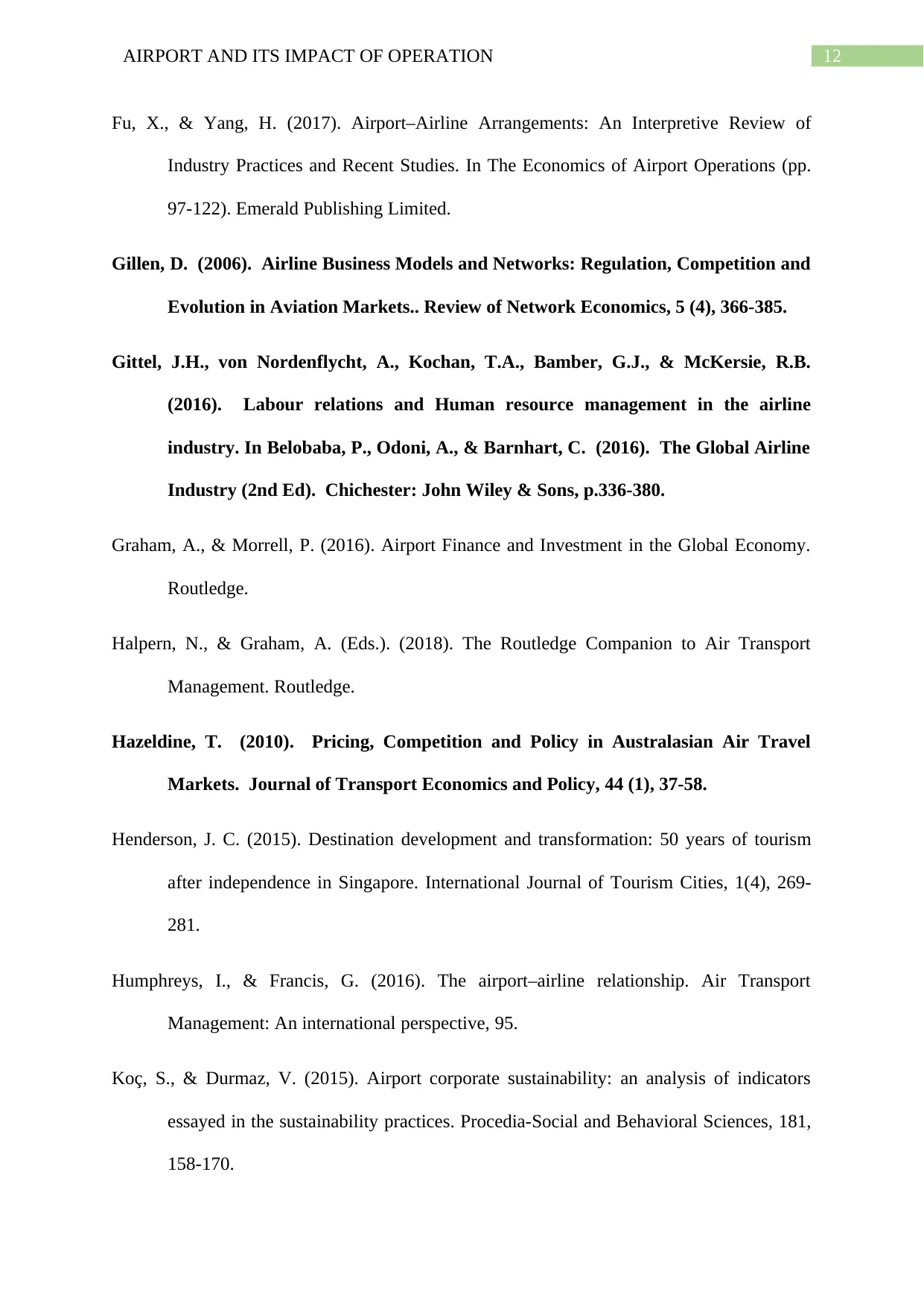
12AIRPORT AND ITS IMPACT OF OPERATION
Fu, X., & Yang, H. (2017). Airport–Airline Arrangements: An Interpretive Review of
Industry Practices and Recent Studies. In The Economics of Airport Operations (pp.
97-122). Emerald Publishing Limited.
Gillen, D. (2006). Airline Business Models and Networks: Regulation, Competition and
Evolution in Aviation Markets.. Review of Network Economics, 5 (4), 366-385.
Gittel, J.H., von Nordenflycht, A., Kochan, T.A., Bamber, G.J., & McKersie, R.B.
(2016). Labour relations and Human resource management in the airline
industry. In Belobaba, P., Odoni, A., & Barnhart, C. (2016). The Global Airline
Industry (2nd Ed). Chichester: John Wiley & Sons, p.336-380.
Graham, A., & Morrell, P. (2016). Airport Finance and Investment in the Global Economy.
Routledge.
Halpern, N., & Graham, A. (Eds.). (2018). The Routledge Companion to Air Transport
Management. Routledge.
Hazeldine, T. (2010). Pricing, Competition and Policy in Australasian Air Travel
Markets. Journal of Transport Economics and Policy, 44 (1), 37-58.
Henderson, J. C. (2015). Destination development and transformation: 50 years of tourism
after independence in Singapore. International Journal of Tourism Cities, 1(4), 269-
281.
Humphreys, I., & Francis, G. (2016). The airport–airline relationship. Air Transport
Management: An international perspective, 95.
Koç, S., & Durmaz, V. (2015). Airport corporate sustainability: an analysis of indicators
essayed in the sustainability practices. Procedia-Social and Behavioral Sciences, 181,
158-170.
Fu, X., & Yang, H. (2017). Airport–Airline Arrangements: An Interpretive Review of
Industry Practices and Recent Studies. In The Economics of Airport Operations (pp.
97-122). Emerald Publishing Limited.
Gillen, D. (2006). Airline Business Models and Networks: Regulation, Competition and
Evolution in Aviation Markets.. Review of Network Economics, 5 (4), 366-385.
Gittel, J.H., von Nordenflycht, A., Kochan, T.A., Bamber, G.J., & McKersie, R.B.
(2016). Labour relations and Human resource management in the airline
industry. In Belobaba, P., Odoni, A., & Barnhart, C. (2016). The Global Airline
Industry (2nd Ed). Chichester: John Wiley & Sons, p.336-380.
Graham, A., & Morrell, P. (2016). Airport Finance and Investment in the Global Economy.
Routledge.
Halpern, N., & Graham, A. (Eds.). (2018). The Routledge Companion to Air Transport
Management. Routledge.
Hazeldine, T. (2010). Pricing, Competition and Policy in Australasian Air Travel
Markets. Journal of Transport Economics and Policy, 44 (1), 37-58.
Henderson, J. C. (2015). Destination development and transformation: 50 years of tourism
after independence in Singapore. International Journal of Tourism Cities, 1(4), 269-
281.
Humphreys, I., & Francis, G. (2016). The airport–airline relationship. Air Transport
Management: An international perspective, 95.
Koç, S., & Durmaz, V. (2015). Airport corporate sustainability: an analysis of indicators
essayed in the sustainability practices. Procedia-Social and Behavioral Sciences, 181,
158-170.
⊘ This is a preview!⊘
Do you want full access?
Subscribe today to unlock all pages.

Trusted by 1+ million students worldwide
1 out of 13
Related Documents
Your All-in-One AI-Powered Toolkit for Academic Success.
+13062052269
info@desklib.com
Available 24*7 on WhatsApp / Email
![[object Object]](/_next/static/media/star-bottom.7253800d.svg)
Unlock your academic potential
Copyright © 2020–2025 A2Z Services. All Rights Reserved. Developed and managed by ZUCOL.





